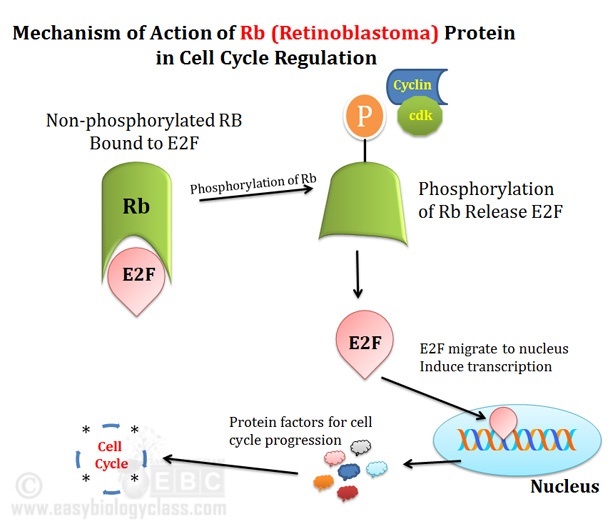What is Retinoblastoma?
Retinoblastoma or RB is a type of cancer affecting the retina of young individuals. RB occurs in the human population both spontaneously and as a heritable disorder. The genetic reason for the occurrence of RB is associated with a structural aberration of the chromosome. In human, the Rb gene is present on the chromosome 13 at the q-14 region. The loss of this region of due to deletion or mutation causes the retinoblastoma.
The condition of retinoblastoma arises only when both the copies of the Rb gene are lost. In the inherited form of the disease, one parental chromosome carries an alteration in this region. A spontaneous mutation in the retinal cells which results in the inactivation of the other copy of Rb gene can cause the tumor development. Thus, the loss of function of Rb protein due to mutation or deletion is the cause of retinoblastoma.
How Rb acts as a tumor suppressor gene?
A tumor suppressor gene is a gene that prevents the development of cancer. When this gene is mutated and its function is lost forever, there is a very high chance of the cell to enter into a cancerous growth.
| You may also like NOTES in... | ||
|---|---|---|
| BOTANY | BIOCHEMISTRY | MOL. BIOLOGY |
| ZOOLOGY | MICROBIOLOGY | BIOSTATISTICS |
| ECOLOGY | IMMUNOLOGY | BIOTECHNOLOGY |
| GENETICS | EMBRYOLOGY | PHYSIOLOGY |
| EVOLUTION | BIOPHYSICS | BIOINFORMATICS |
The gene product of Rb (named as pRb) acts as a tumor suppressor protein. pRb is a phosphoprotein resides in the nucleus. It can be converted to active and inactive forms by the process of phosphorylation and dephosphorylation. In the nucleus, the pRb influence the cell division process by preventing the progression of cell cycle. The pRb is phosphorylated by some cyclin/cdk complexes, particularly Cyclin D/CDK4/CDK6, in the specific stages of the cell cycle. When the cells are in the G0/G1 stage, the pRb occurs as non-phosphorylated form. The non-phosphorylated pRb is the active form which binds to several proteins associated with cell cycle progression particularly before the S phase. The binding of pRb to these proteins cause its inactivation. By the end of the G1 stage of cell cycle, the pRb is phosphorylated by the cyclin-cdk complex. The phosphorylation of pRb causes its inactivation. The inactivated pRb release all the bound proteins and thus the cell can progress to S phase.
Among the different target proteins of pRb, the most important are the E2F category of transcription factors. The E2F transcription factors can activate many target genes whose products are essential for the progression of S phase of cell cycle. The binding of non-phosphorylated pRb to E2F transcription factors inhibit the ability of E2F to activate transcription. Thus blocking the activity of E2F, the native pRb (non-phosphorylated pRb) can stop the cell from entering into S phase and thus it can block the advancement of cell cycle. Moreover, the pRb-E2F complex can also directly repress some other target genes.

For the cell cycle progression, the activity of non-phosphorylated pRb should be suppressed. The activity of pRb can be suppressed by its phosphorylation (by cyclin/cdk complex). The phosphorylated pRb release the bound E2F transcription factors and that can induce the expression of genes which are essential for cell cycle progression.
How deficiency or mutations in Rb cause the development of cancer?
If pRb is not expressed in the cell, the E2F transcription factors will be always free and they will actively transcribe genes which are required for the cell cycle to advance from G1 to S phase. In this condition, the cell will lose its ability to halt the cell cycle process by checkpoints. In the absence of checkpoints, cells with lethal mutations will continue to divide and it ultimately leads to the development of cancers. Moreover, in the absence of proper gap periods, the cells will not get enough time to synthesize the useful components for the successful completion of cell division and its growth.
| You may also like... | ||
|---|---|---|
| NOTES | QUESTION BANK | COMPETITIVE EXAMS. |
| PPTs | UNIVERSITY EXAMS | DIFFERENCE BETWEEN.. |
| MCQs | PLUS ONE BIOLOGY | NEWS & JOBS |
| MOCK TESTS | PLUS TWO BIOLOGY | PRACTICAL |
<<Back to Molecular Biology Notes
